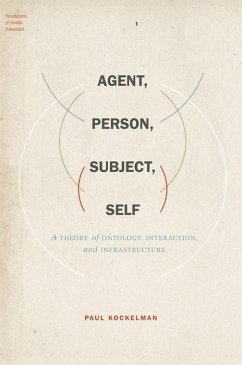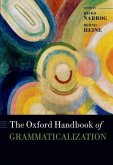- Gebundenes Buch
- Merkliste
- Auf die Merkliste
- Bewerten Bewerten
- Teilen
- Produkt teilen
- Produkterinnerung
- Produkterinnerung
This books offers a naturalistic and critical theory of signs, minds, and meaning-in-the-world.
Andere Kunden interessierten sich auch für
![Person, Case, and Agreement Person, Case, and Agreement]() Andras BaranyPerson, Case, and Agreement152,99 €
Andras BaranyPerson, Case, and Agreement152,99 €![Oxford Handbook of Language and Society Oxford Handbook of Language and Society]() Oxford Handbook of Language and Society238,99 €
Oxford Handbook of Language and Society238,99 €![The Oxford Handbook of Construction Grammar The Oxford Handbook of Construction Grammar]() Thomas HoffmannThe Oxford Handbook of Construction Grammar241,99 €
Thomas HoffmannThe Oxford Handbook of Construction Grammar241,99 €![Structuring Sense Structuring Sense]() Hagit BorerStructuring Sense181,99 €
Hagit BorerStructuring Sense181,99 €![Oxford Handbook of Grammaticalization Oxford Handbook of Grammaticalization]() Oxford Handbook of Grammaticalization258,99 €
Oxford Handbook of Grammaticalization258,99 €![The Origins of Grammar The Origins of Grammar]() James R HurfordThe Origins of Grammar98,99 €
James R HurfordThe Origins of Grammar98,99 €![Endangered Languages Endangered Languages]() Endangered Languages146,99 €
Endangered Languages146,99 €-
-
-
This books offers a naturalistic and critical theory of signs, minds, and meaning-in-the-world.
Hinweis: Dieser Artikel kann nur an eine deutsche Lieferadresse ausgeliefert werden.
Hinweis: Dieser Artikel kann nur an eine deutsche Lieferadresse ausgeliefert werden.
Produktdetails
- Produktdetails
- Verlag: Hurst & Co.
- Seitenzahl: 256
- Erscheinungstermin: 18. Dezember 2012
- Englisch
- Abmessung: 234mm x 157mm x 25mm
- Gewicht: 499g
- ISBN-13: 9780199926985
- ISBN-10: 0199926980
- Artikelnr.: 38592369
- Herstellerkennzeichnung
- Libri GmbH
- Europaallee 1
- 36244 Bad Hersfeld
- 06621 890
- Verlag: Hurst & Co.
- Seitenzahl: 256
- Erscheinungstermin: 18. Dezember 2012
- Englisch
- Abmessung: 234mm x 157mm x 25mm
- Gewicht: 499g
- ISBN-13: 9780199926985
- ISBN-10: 0199926980
- Artikelnr.: 38592369
- Herstellerkennzeichnung
- Libri GmbH
- Europaallee 1
- 36244 Bad Hersfeld
- 06621 890
Paul Kockelman is a linguistic anthropologist, with a strong area focus in Latin America, who is broadly interested in the relation between meaning, value, and information. His scholarship, developed in more than 25 articles, has focused on a broad set of interrelated topics concerning language, culture and mind. Methodologically, he draws on his empirical research to analyze relations among grammatical categories, discourse patterns, social relations, and cultural values as they unfold in both face-to-face and more mediated forms of interaction. His research has been sustained by extensive linguistic and ethnographic fieldwork, primarily among speakers of Q'eqchi'-Maya living in the cloud forests of highland Guatemala, and now more and more among scientists and engineers working on and with a variety of information technologies.
Figures
Tables
1. Semiotic Ontologies
1. Signs, Minds, and Meaning-in-the-World
2. Ontology, Interaction, and Infrastructure
2. Biosemiosis, Technocognition, and Sociogenesis
1. Relations between Relations
2. Significance and Selection
3. Communication between Conspecifics
4. The Organization of Cognitive Processes
5. Framing
6. Artificial and Natural Selection, Sieving and Serendipity
7. Lawn-Mowers and Logic Gates
8. Relations between Relations Revisited
9. Networks of Interconnected Envorganisms
10. The Evolution and Epidemiology of Culture
3. Enclosing and Disclosing Worlds
1. The Neo-Organon
2. Semiotic Processes, Social Theories, and Obviated Ontologies
3. Social Statuses, Material Substances, and Mental States
4. Relatively Emblematic Indices
5. Semiotic Agents and Generalized Others
6. From Performativity to Transformativity
4. Residence in the World
1. From Being-in-the-World to Meaning-in-the-World
2. Heeding Affordances
3. Wielding Instruments
4. Undertaking Actions
5. Inhabiting Roles
6. Fulfilling Identities
7. From Acting Under a Description to Comporting Within an Interpretation
5. Representations of the World
1. Intentionality Reframed
2. Cognitive Representations
3. Discursive Practices
4. From Theory of Mind to the Interpretation of Signs
5. Intentionality and Emblemeticity
6. Selfhood, Affect, and Value
1. I Err Therefore I am
2. From Subjectivity to Selfhood
3. From Cognition to Affect
4. Maps, Terrains, and Travelers
5. From Meaning to Value
Tables
1. Semiotic Ontologies
1. Signs, Minds, and Meaning-in-the-World
2. Ontology, Interaction, and Infrastructure
2. Biosemiosis, Technocognition, and Sociogenesis
1. Relations between Relations
2. Significance and Selection
3. Communication between Conspecifics
4. The Organization of Cognitive Processes
5. Framing
6. Artificial and Natural Selection, Sieving and Serendipity
7. Lawn-Mowers and Logic Gates
8. Relations between Relations Revisited
9. Networks of Interconnected Envorganisms
10. The Evolution and Epidemiology of Culture
3. Enclosing and Disclosing Worlds
1. The Neo-Organon
2. Semiotic Processes, Social Theories, and Obviated Ontologies
3. Social Statuses, Material Substances, and Mental States
4. Relatively Emblematic Indices
5. Semiotic Agents and Generalized Others
6. From Performativity to Transformativity
4. Residence in the World
1. From Being-in-the-World to Meaning-in-the-World
2. Heeding Affordances
3. Wielding Instruments
4. Undertaking Actions
5. Inhabiting Roles
6. Fulfilling Identities
7. From Acting Under a Description to Comporting Within an Interpretation
5. Representations of the World
1. Intentionality Reframed
2. Cognitive Representations
3. Discursive Practices
4. From Theory of Mind to the Interpretation of Signs
5. Intentionality and Emblemeticity
6. Selfhood, Affect, and Value
1. I Err Therefore I am
2. From Subjectivity to Selfhood
3. From Cognition to Affect
4. Maps, Terrains, and Travelers
5. From Meaning to Value
Figures
Tables
1. Semiotic Ontologies
1. Signs, Minds, and Meaning-in-the-World
2. Ontology, Interaction, and Infrastructure
2. Biosemiosis, Technocognition, and Sociogenesis
1. Relations between Relations
2. Significance and Selection
3. Communication between Conspecifics
4. The Organization of Cognitive Processes
5. Framing
6. Artificial and Natural Selection, Sieving and Serendipity
7. Lawn-Mowers and Logic Gates
8. Relations between Relations Revisited
9. Networks of Interconnected Envorganisms
10. The Evolution and Epidemiology of Culture
3. Enclosing and Disclosing Worlds
1. The Neo-Organon
2. Semiotic Processes, Social Theories, and Obviated Ontologies
3. Social Statuses, Material Substances, and Mental States
4. Relatively Emblematic Indices
5. Semiotic Agents and Generalized Others
6. From Performativity to Transformativity
4. Residence in the World
1. From Being-in-the-World to Meaning-in-the-World
2. Heeding Affordances
3. Wielding Instruments
4. Undertaking Actions
5. Inhabiting Roles
6. Fulfilling Identities
7. From Acting Under a Description to Comporting Within an Interpretation
5. Representations of the World
1. Intentionality Reframed
2. Cognitive Representations
3. Discursive Practices
4. From Theory of Mind to the Interpretation of Signs
5. Intentionality and Emblemeticity
6. Selfhood, Affect, and Value
1. I Err Therefore I am
2. From Subjectivity to Selfhood
3. From Cognition to Affect
4. Maps, Terrains, and Travelers
5. From Meaning to Value
Tables
1. Semiotic Ontologies
1. Signs, Minds, and Meaning-in-the-World
2. Ontology, Interaction, and Infrastructure
2. Biosemiosis, Technocognition, and Sociogenesis
1. Relations between Relations
2. Significance and Selection
3. Communication between Conspecifics
4. The Organization of Cognitive Processes
5. Framing
6. Artificial and Natural Selection, Sieving and Serendipity
7. Lawn-Mowers and Logic Gates
8. Relations between Relations Revisited
9. Networks of Interconnected Envorganisms
10. The Evolution and Epidemiology of Culture
3. Enclosing and Disclosing Worlds
1. The Neo-Organon
2. Semiotic Processes, Social Theories, and Obviated Ontologies
3. Social Statuses, Material Substances, and Mental States
4. Relatively Emblematic Indices
5. Semiotic Agents and Generalized Others
6. From Performativity to Transformativity
4. Residence in the World
1. From Being-in-the-World to Meaning-in-the-World
2. Heeding Affordances
3. Wielding Instruments
4. Undertaking Actions
5. Inhabiting Roles
6. Fulfilling Identities
7. From Acting Under a Description to Comporting Within an Interpretation
5. Representations of the World
1. Intentionality Reframed
2. Cognitive Representations
3. Discursive Practices
4. From Theory of Mind to the Interpretation of Signs
5. Intentionality and Emblemeticity
6. Selfhood, Affect, and Value
1. I Err Therefore I am
2. From Subjectivity to Selfhood
3. From Cognition to Affect
4. Maps, Terrains, and Travelers
5. From Meaning to Value








